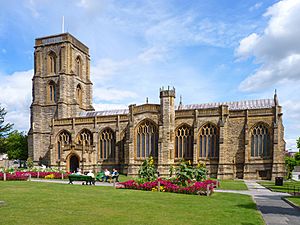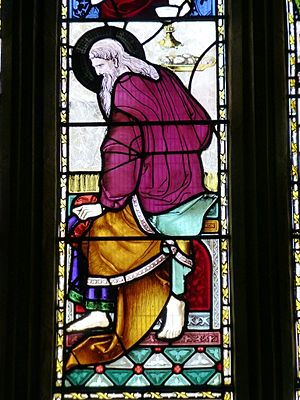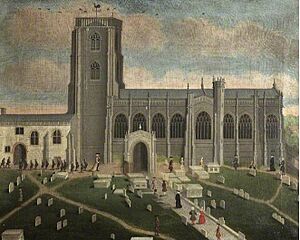Church of St John the Baptist, Yeovil facts for kids
Quick facts for kids Church of St John the Baptist |
|
|---|---|
 |
|
| Location | BA20 1HE, Yeovil, Somerset, England |
| Built | Late 14th century |
|
Listed Building – Grade I
|
|
| Designated | 19 March 1951 |
| Reference no. | 261341 |
| Lua error in Module:Location_map at line 420: attempt to index field 'wikibase' (a nil value). | |
The Church of St John the Baptist is a very old church located in Yeovil, Somerset, England. It is a Church of England parish church, which means it serves the local community. This amazing building was constructed a long time ago, between 1380 and 1405.
The church is considered a Grade I listed building, which is the highest level of protection for historic buildings in England. This shows how important and special it is! Over the years, the church has been updated, with major renovations happening in the 1850s.
History of St John's Church
The main part of the Church of St John the Baptist was built over 600 years ago. The tall tower, which stands about 92 feet (28 meters) high, was added around 1480. Experts believe that a famous builder named William Wynford, who also worked on Wells Cathedral, might have helped design it.
As the town of Yeovil grew, more space was needed for people to worship. So, a second church, Holy Trinity, was started in 1843. This helped ease the pressure on St John's. Later, in 1863, a new cemetery called Preston Road cemetery was opened because the churchyard was running out of space.
Church Architecture and Features
The church tower has beautiful stone railings at the top, called openwork balustrading, which match the walls below. These parts were added in the 1600s. The tower also has windows from the late 1300s, with cool stone designs. You can find a spiral staircase in one corner of the tower, leading up to a weather vane at the very top.
Inside the tower are fourteen bells! Two of these bells were made in 1728 by the Bilbie family, who were famous bell makers. One of the largest bells, called the "Great Bell," was remade in 2013. It now weighs about 4,992 pounds (2,264 kilograms).
Unfortunately, some of the outside stone of the church needs repair. Because of this, the church has been placed on the Heritage at Risk Register. This means it needs special attention to keep it safe for the future.
One very interesting feature inside the church is its stained glass windows. One window shows Judas Iscariot, a figure from the Bible, with a dark halo. This is quite unusual! The church also has a special brass reading desk that was originally made in East Anglia.
The Church of St John the Baptist is part of a group of churches in the Diocese of Bath and Wells. It works together with St Andrew, another church in Yeovil.
The Chantry School
Next to the Church of St John the Baptist, there used to be a building called the Chantry of St Mary the Virgin. In 1573, this building was turned into a schoolroom by the local community. It became a charity school, which provided education for children.
In 1855, the old schoolroom was taken down. A new building, also called the Chantry, was built nearby. Some parts of the old building, like two fireplaces, were saved and put into the new one. Even the roof design of the old school was copied for the new Chantry. Over time, this charity school grew and became known as Yeovil Grammar School. It closed its doors in 1907 when its head teacher retired.
See also
- List of Grade I listed buildings in South Somerset
- List of towers in Somerset



